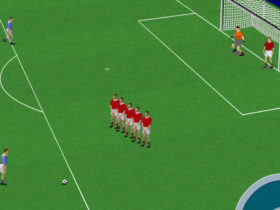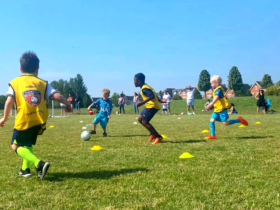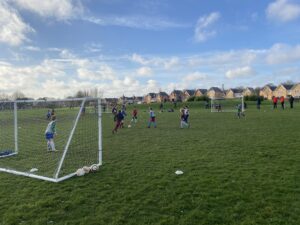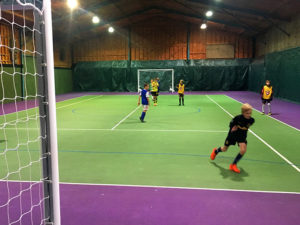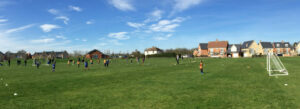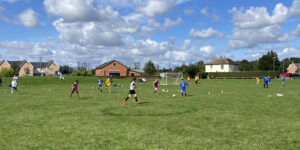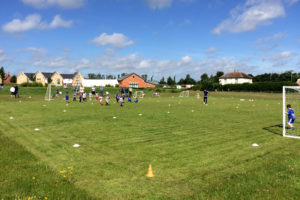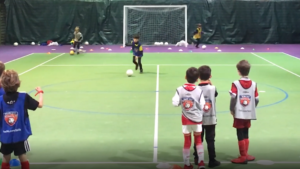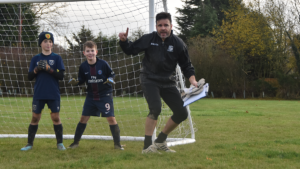After Friday’s focus on developing coaching sessions and the practice spectrum, we returned to the venue literally a stone’s throw from Colchester United’s old Layer Road ground – now a housing estate – to talk about skill.
Thinking back to the Level Two course and when the question ‘what is skill?’ was asked, it didn’t receive an instant reply. It’s often mixed up with technique or ability, but as we learned it’s fairly easy to define.
Our Module Two course tutors, Gary Piggott from Essex FA and Alan Ackrell, explained it pretty well. Skill is knowing how, when and where to use a certain technique, for example, if you want to take on an opponent.
To practise a skill you need a target or a goal (dribbling the ball from point A to point B), you need an opposition (something to beat to get to point B) and, Alan also argues, a co-operating player to help you and provide you with a decision to make – do I take the player on or do I pass to a team-mate?
Ultimately, if you and a team-mate want to carry the ball from one end of the field to the other taking on individual players in turn, then of course you can pass it between yourself around the defenders. You will achieve your goal if you can pass the ball well and know how to provide the right support angle.
But the better defenders will potentially cotton on to that, so the attackers will need to look for another option, ie take on the defenders themselves, using a practised technique, demonstrating skill.
So Saturday morning was spent in the classroom discussing skill and how to develop it in a player before we headed outside to look at some practices.
This time I got involved myself – it’s what Saturdays were invented for after all – and we played a game that was reminiscent of ‘Gauntlet’ from the old Gladiators programme, minus giant earbuds and Jet.
The 30-yard pitch was marked up with two channels, one five yards wide, one a little wider. Each channel was made up of 10-yard boxes, with a defender in each [see below image].
There were various adaptations and progressions, one being goals at the end of channels with a keeper.
Attackers, in pairs with one ball, attempted to work their way through each box taking on the defenders in their way, then coming back down the other channel.
Some pairs were finding it difficult, mainly due to bad passes or decision making, but it gave Alan and Gary the chance to regress the practice to make it easier for the attackers. Each defender had to stay on their box’s back line, so they could only shuffle side to side, giving the pairs a little more time.
It highlighted what we as coaches can do with practices – alter and develop them in line with the players needs, not how a book is telling you to progress.
When we stopped the practice, I made the point that many players were opting to pass the ball around the defender, perhaps a little frightened to take on the opponent or not wanting to leave their team-mate with nothing to do.
Not that there was anything wrong with that or with the session, but depending on the desired outcome – maybe we want to encourage players to take on a opponent – then perhaps it could have been a straight 1v1, or even 1v1 with a supporting player if needed. Roles could then swap for the next go around so all players get equal practice time.
The player would perhaps then feel braver and take on the defenders, experiment, try things out and see what works, what doesn’t. Only after those experiences will players feel confident enough to try the same things in a game.
And as much as we love a tough tackler, or an economical passer, it’s those that take players on, game-changers, who get us off our feet.
So with one very simple practice, we were able to see many ways to develop it depending on the desired outcome and the players involved. Then we can give the players the chance to play and try to work problems out for themselves.
That was the essence of the final game of the day, which wrapped up the first half of the Module Two course. I decided to sit out and let others have a go, and was able to watch what is a very simple game to set up.
It was essentially an 8v8 game, with two keepers, which Alan said he’d seen Jose Mourinho put on with the Chelsea first team.
Each team is split into two fours in separate coloured bibs and are left to play 8v8 with one condition – you can’t pass to a team-mate wearing the same coloured bib. [In the below example and download, red and orange are one team, navy and light blue the other. Keepers are purple]
It brings in another element of skill development as it works on players’ visual and perceptual skills, looking for the options and needing to understand what’s around them before they even get the ball. It also encourages players to think about supporting the man on the ball, and creating space.
You could clearly see the players struggling to begin with, but after a few minutes those in possession started to look up more, while team-mates would be working to make an angle in space or provide a option short.
It’s a game like which requires little intervention from the coach as players will start to think, learn and progress on their own, just with the condition added at the start.
I’ve drawn the session up using the new FA Coach’s App for anyone who’d like to try it for themselves. Click here to download the session plan.
Again, it’s adaptable, depending on your desired outcome. But it’s definitely one I’ll be trying with my teams.
On Friday we meet up again for the final two days and in the meantime I have some course reading to go through. You never stop learning.



